Travel Notes from Pastor Stephen: Sachsenhausen
April 19, 2023Content Warning: Today’s reflection includes some disturbing details about what happened at a concentration camp near Berlin.
Today I had the sobering experience of visiting Sachsenhausen Concentration Camp. It was a profound experience, made more so by our visit to the Memorial to the Murdered Jews of Europe yesterday and my own visit to the Yad Vashem (the Holocaust Museum in Jerusalem) several years ago. It’s a place no one particularly wants to go (for enjoyment) but should go. Our guide shared his own mixed feelings with taking so many people there; he had a sense of fulfillment and purpose in sharing what he knew with others, but it is also a part of that hard history that can weigh on you.
I have studied the Holocaust in various ways (courses in college, reading in seminary, my own curiosity), but seeing it up close was a new experience. It put flesh and bone, brick and mortar to the horror, and I learned small details and stories you don’t get from courses and books. Courtney can share a lot more about this, but it’s a bit like slavery in the US. Most people know a bit about it and a few bad things and stories, but unless you really study it and go to the places where it happened and talk to the experts there, you don’t really know how horrible it really was. I think the Holocaust is similar. You can read and watch programs, but the deeper you go, the more horrors and atrocities and derangement you will discover.
The SS established the Sachsenhausen concentration camp as the principal concentration camp for the Berlin area. Located near Oranienburg, north of Berlin, the Sachsenhausen camp opened on July 12, 1936, when the SA (brown shirts) transferred 50 prisoners from another camp to begin construction of Sachsenhausen. By the end of 1936, the camp held 1,600 prisoners, who were mostly political prisoners. The camp at its peak held over 50,000 prisoners ranging from communists, prisoners of war, homosexuals, ethnic groups such as the Roma and Sinti people, and Jews. Prisoners of Sachsenhausen included Pastor Martin Niemöller, former Austrian chancellor Kurt von Schuschnigg, and Joseph Stalin’s son, Yakov Dzhugashvili.
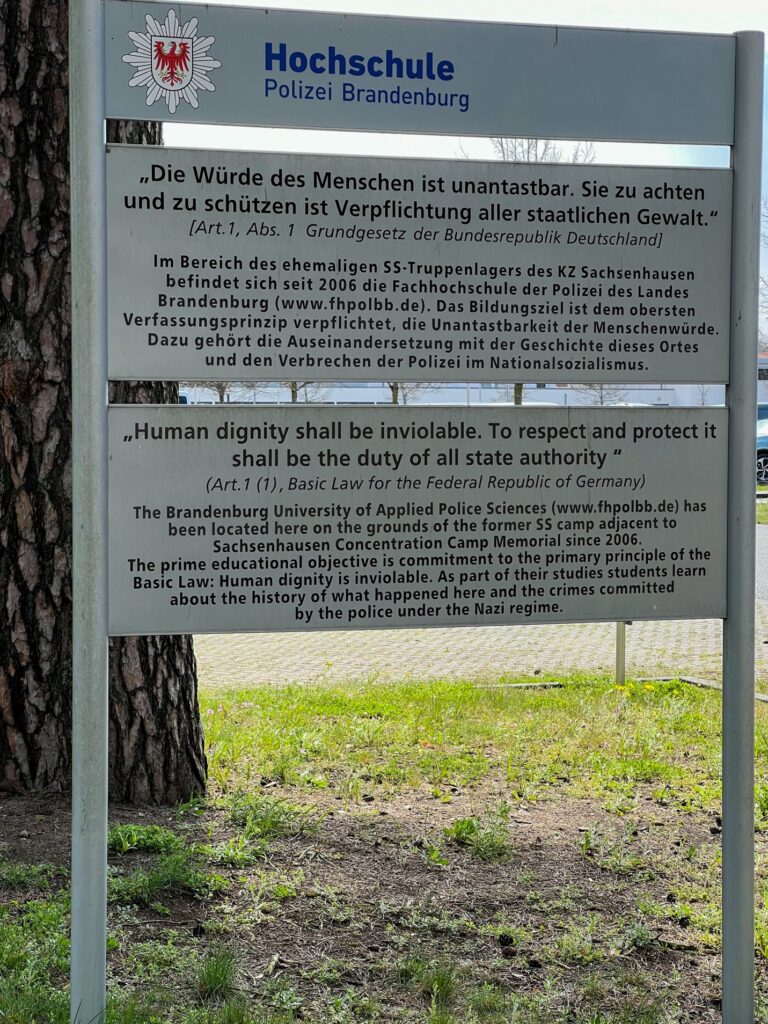
Before you enter the actual concentration camp gates, you pass a few buildings on the other side of the street. These two massive, unattractive, military style buildings were used to train SS guards. Today, they are used to train the local police force. This is Germany’s way of continually reminding its people, especially those gaining a certain amount of power, of the dangers that come with that power and a warning not to repeat history. I find it incredibly wise, insightful, and courageous to train those who will gain power in the shadow of the atrocities power can do. There’s a sign you can see near the buildings from the path in Sachsenhausen with the first article of the German Constitution and a reminder of why police are trained there.
Until around 1990 it was required of every German student to visit a concentration camp. It is no longer required, but it is rare for a student not to visit one. I never went to a place with a hard history on a field trip, but there were plenty nearby I could have gone to. Luckily, I had parents who took the time to take me to places where I could learn the history of our country: the good, the bad, and the ugly.
We too often want to hide from our history instead of letting it challenge us, convict us, convert us, and maybe even ultimately redeem us. We don’t want it shoved in our faces, but Germany puts it right there for all to see: not just students, not just tourists, but those who would have power and responsibility.
After arriving at the actual camp, our first stop was Tower A, or the entrance of the camp grounds. This structure is the only entrance and exit that Sachsenhausen has. It’s a rather typical-looking entrance, resembling the famous picture of Auschwitz not only in structure, but also in history: over 200,000 prisoners were registered in front of and passed through it. A much smaller number was able to come out, some dying of malnutrition, others of cold, and some through suicide by throwing themselves at the electrical fence, but Sachsenhausen was not an “extermination camp” like Treblinka and Auschwitz.
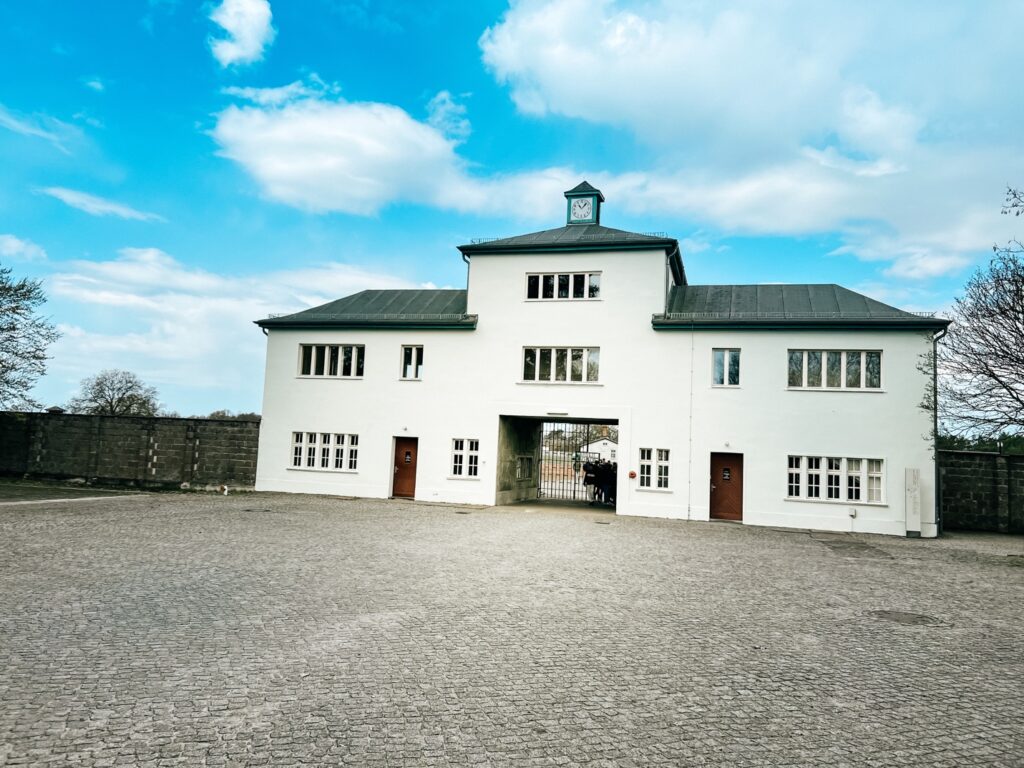
While the entrance might have looked typical, the camp is very different from other camps. For one, Sachsenhausen was built in the shape of an equilateral triangle, with its roll-call area (where the prisoners were counted every morning and evening) directly in the center. It was modeled after a Panoptical – the ideal prison, where the prisoners felt exposed to the eye of the guard at all times. It was, in the words of Heinrich Himmler, the prototype of the “modern, up-to-date, ideal and easily expandable concentration camp” (1937), the ultimate symbol of Nazi oppression and terror. Machine guns on top of Tower A could easily see and shoot everywhere a prisoner could be or go.
Today, little remains of the original landscape of the camp: just a few buildings. The outline of many more are laid out in iron and stone. It’s much more open now, allowing visitors to see the camp from end to end and wonder, how it is possible for a camp designed for 3,000 people to house as many as 58,000 people at one time at its peak?
Unlike places such as Auschwitz, the buildings at Sachsenhausen have mostly disappeared. A few originals remain and a few have been rebuilt. According to German law they can only be rebuilt using original material. The emptiness of the camp gives it a chilling effect, but what it lacks is the feeling of overcrowdedness which certainly existed when the Nazis used it to hold at least six times the number of people it was originally intended for.
One of the barracks has been reconstructed and turned into a Jewish Museum. We saw the small room where hundreds would be kept, three to a bunk.
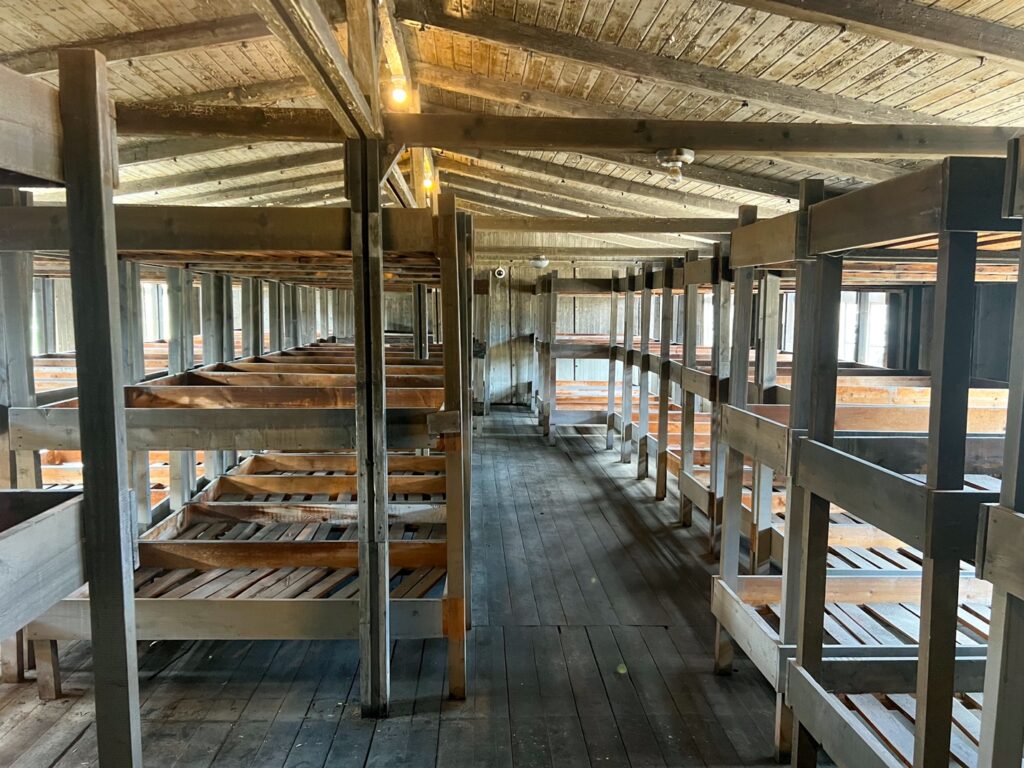
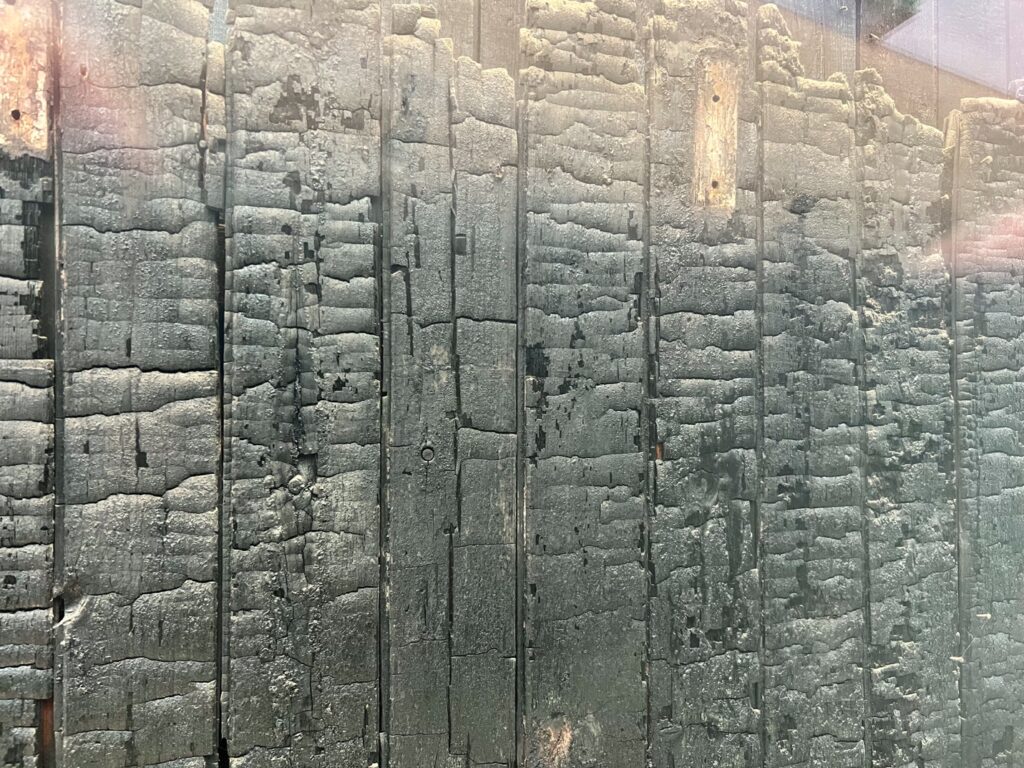
In 1992 neo-Nazis broke into the camp and attempted to burn the museum down. They were unsuccessful in destroying the building but did cause damage. The building was not redone; instead, the damaged and charred ceiling and was left as a reminder that persecution and hatred is not entirely a thing of the past, but rather an attitude which still is with us today.
Once again, I think we can learn from Germans. They refuse to whitewash the sins of yesterday and today. Yes, there are those who may think Anti-Semitism is a thing of the past in Germany, but choices like this one force us to confront the truth that it is not. I understand cleaning the graffiti of Nazi symbolism off memorials in the US, but what if we left it there so we would have to reckon with the Anti-Semitic reality that is so real and constant for so many of our neighbors? What if we stopped fixing what hate attempts to deface and destroy and instead shine light on the hate that still persists and pervades everything in the hope that hate will write its own obituary? I certainly understand why we wouldn’t want some hateful graffiti on monuments; it can trigger people, it gives it a spotlight, etc. But I can also see where in some instances it might be wise not to just repair what hate tries to destroy.

Over the course of our time at Sachsenhausen we learned about the camp, its guards and leaders, and its prisoners. There are eerie and disturbing pictures of guards and commandants looking positively gleeful and nonchalant as they observe the abject suffering right in front of them, sometimes even kneeling right at their feet.
We saw original artifacts used to torture and punish prisoners. It’s not some far off historical idea: it’s right in front of you, staring you in the face. This happened to men who were probably not much different than me. It reminds me I don’t have to look in my own country to find this sort of horror, whether it’s slavery, treatment of indigenous people, or things that happen in our own industrial prison system. Some of the pictures at Sachsenhausen reminded me of the pictures I saw of guards in US military uniforms at Abu Ghraib prison.
The number of Jewish prisoners in Sachsenhausen varied over the course of the camp’s existence, but ranged from 21 at the beginning of 1937 to 11,100 at the beginning of 1945. Many of the earliest Jewish prisoners were there because of political views and not race. Almost 6,000 Jews arrived in Sachsenhausen in the days following the Kristallnacht (Night of Broken Glass) riots. Many of those prisoners were released in exchange for their promise to emigrate (at their own expense).
There was a marked increase in the number of Jewish prisoners when, in mid-September 1939, shortly after World War II began, German authorities arrested Jews holding Polish citizenship and stateless Jews, most of whom were living in the greater Berlin area, and incarcerated them in Sachsenhausen. Thereafter, the number of Jewish prisoners decreased again, as SS authorities deported them from Sachsenhausen to other concentration camps in occupied Poland, most often Auschwitz, in an effort to make the so-called German Reich “free of Jews” (judenfrei).
In the spring of 1944, SS authorities began to bring thousands of Hungarian and Polish Jews from ghettos and other camps to Sachsenhausen as the need for forced laborers in Sachsenhausen and its subcamps increased. Many of these new Jewish prisoners were women. By the beginning of 1945 the number of Jewish prisoners had risen to 11,100.
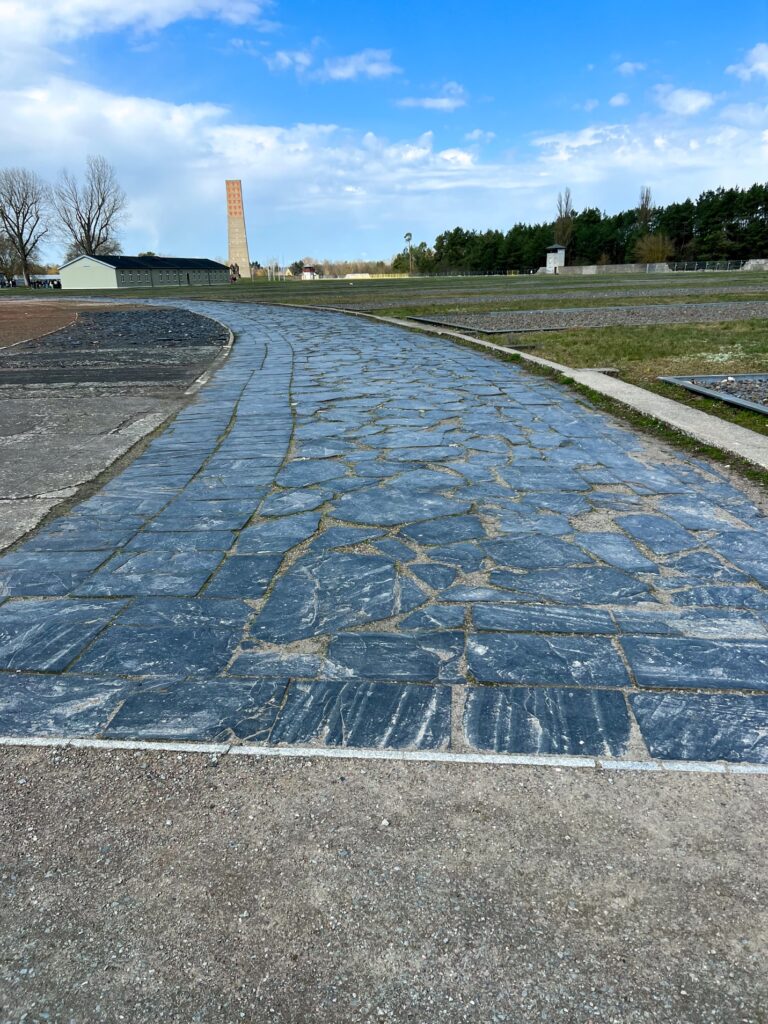
Sachsenhausen wasn’t only a prison; it was a business. Prisoners were used as laborers to make bricks for building projects in Berlin and eventually to remove unexploded bombs in Berlin during the war. We learned that shoe companies tested their shoes, especially hiking boots, at Sachsenhausen. There is a semi-circular stone track in the main courtyard where often prisoners of war (who were in better shape) would be forced to walk mile after mile back and forth with heavy packs to test the soles of boots.
The first group of Soviet prisoners of war arrived in Sachsenhausen at the end of August 1941. By the end of October 1941, the SS had deported about 12,000 Soviet prisoners of war to Sachsenhausen. Camp authorities shot thousands of Soviet POWs shortly after they arrived in the camp through an elaborate ruse. The Soviets would be taken into what looked like a medical facility and greeted by men in white coats and aprons they assumed to be doctors. Their height would be measured and they would be given a token and head to the next room where another “doctor” would check in their mouth. They were checking for gold teeth but the prisoners didn’t know. Then they’d go to another room that was more soundproof and had music playing. There they would stand against another height measuring stick (pictured below) but this time a guard in a hidden room would shoot the prisoner with a small caliber pistol in the back of the neck through the gap in the measuring stick. Other prisoners would then drag out the body to be taken to the nearby ovens. Estimates of Soviet POWs killed at Sachsenhausen range from 11,000-18,000.
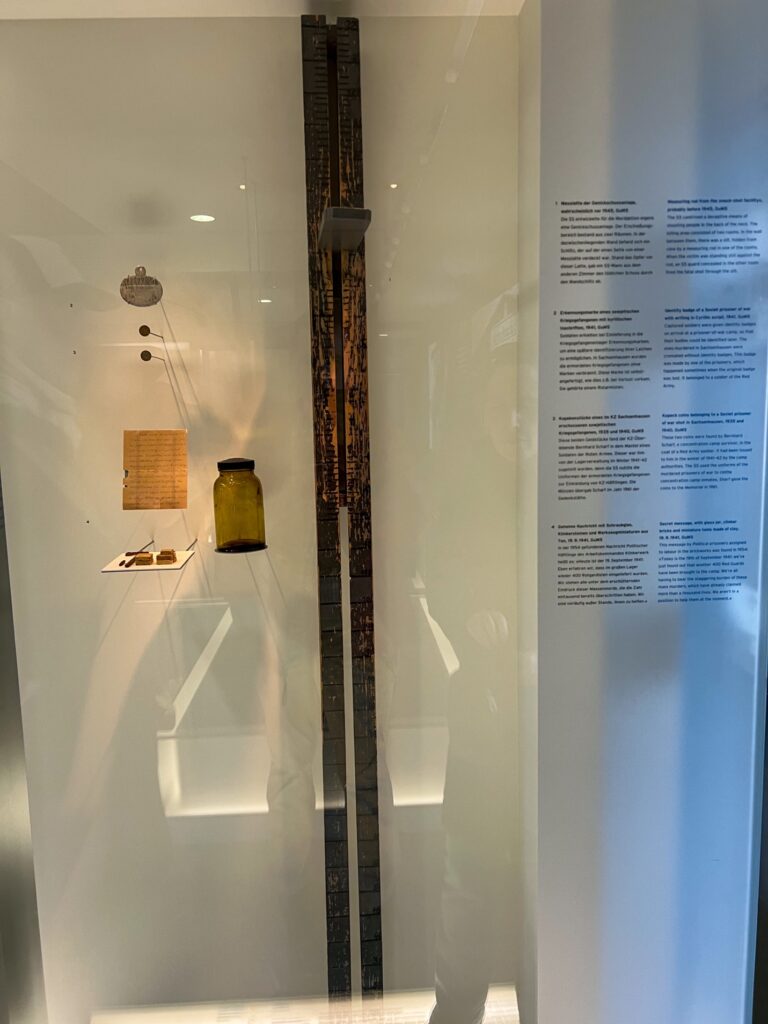
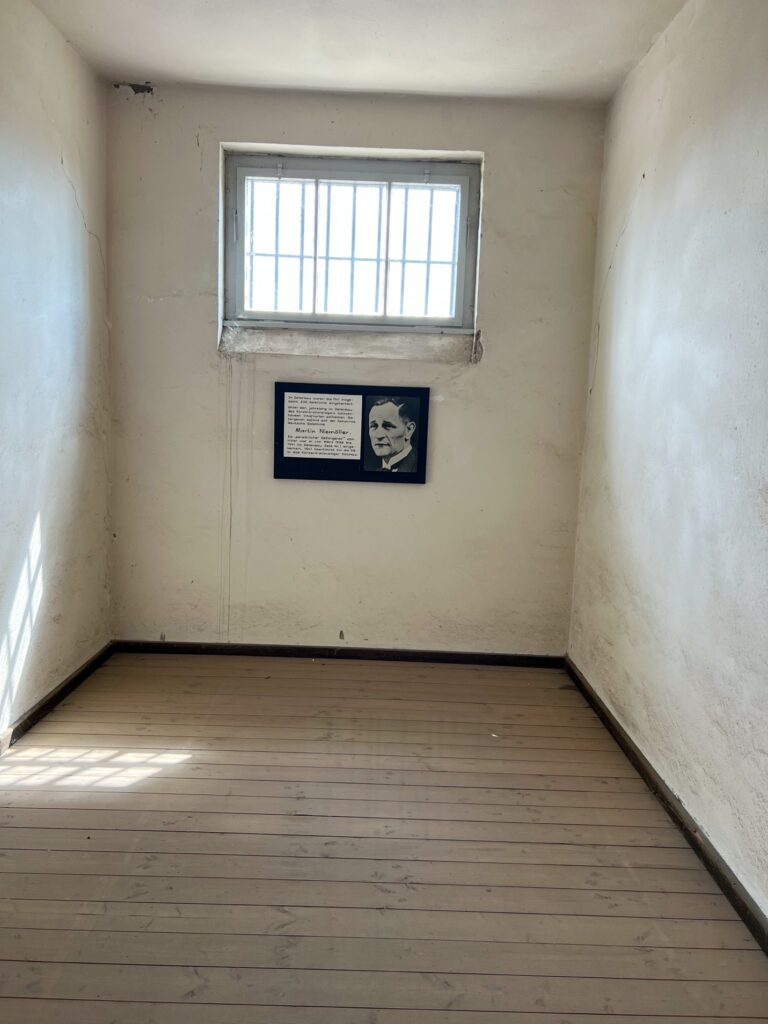
There was a special prison within the camp for prisoners they didn’t want intermingling with other prisoners, or who they wanted to torture in other ways, or keep alive. One of those prisoners was Joseph Stalin’s son. They kept him alive in case he could be used, but when Hitler tried to exchange him for Field Marshal Paulus (he lost the battle of Stalingrad and Hitler wanted him so he could execute Paulus himself), Stalin said, “Why would I trade a Field Marshal for a Corporal?” Stalin’s son was dead shortly after, but it was staged to look like he was killed during an attempted escape.
Martin Niemöller, a Lutheran pastor, was also imprisoned at Sachsenhausen for eventually speaking out against the Nazis as part of the Confessing Church, but not before he initially voted Hitler into power. Niemöller later wrote that he “voted for Hitler because of the Nazi pledge to honor Christianity and to provide Germany with a strong leader who would restore German pride.”
Niemöller said,
“I had an audience with Hitler, as a representative of the Protestant Church, shortly before he became Chancellor, in 1932. Hitler promised me on his word of honor, to protect the church, and not to issue any anti-Church laws. He also agreed not to allow pogroms against the Jews…Hitler’s assurance satisfied me at the time. On the other hand, I hated the growing atheistic movement, which was fostered and promoted by the Social Democrats and the Communists. Their hostility toward the church made me pin my hopes on Hitler for a while. I am paying for that mistake now; and not me alone, but thousands of other persons like me.”
We sometimes forget that Hitler came to power legally. He didn’t lead a military coup. He was voted for by many Germans, but he couldn’t take full control yet because he didn’t have the votes. He actually made a deal with the Vatican and the Catholic church in Germany that got him the votes to suspend democracy and give him emergency powers. The church, Protestant and Catholic, was not just complicit in Nazi Germany, they were willing supporters.
Perhaps you’ve seen the pictures of German churches with Nazi flags on their chancels. This is one reason why pastors get so nervous about signs of nationalism in the church that are mixed into worship. It’s never been a good mix, and Nazi Germany is a not-so-distant memory of how bad it can go when the church and state get together. It’s never gone particularly well, but Nazism is by far the worst example.
After we saw the special prison, we made our way to Station Z. We saw where prisoners were executed by firing squad, which was the easiest and most dignified way to die in Sachsenhausen. The guards at Sachsenhausen had a joke that spread to all the camps: the only way out is through the chimneys.
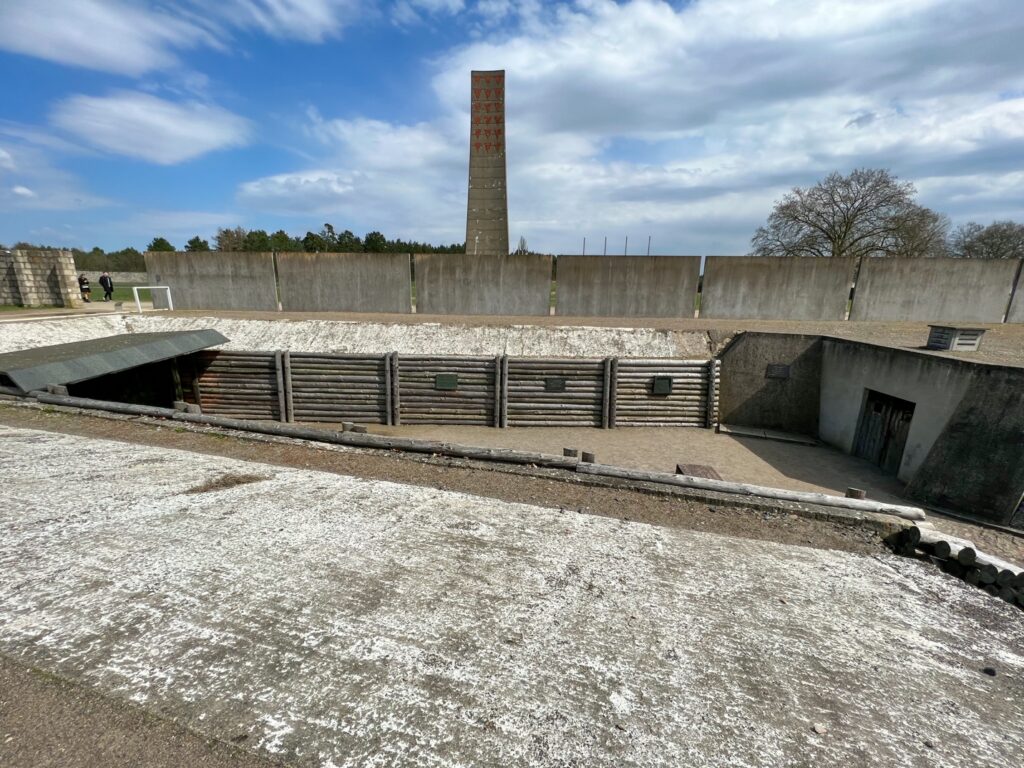
After the firing squad area, we saw what was left, just the foundations of the killing rooms. Sachsenhausen wasn’t an extermination camp like Auschwitz, but it was a sort of testing and proving ground for the Holocaust. Many of the decisions made for camps like Auschwitz happened at Sachsenhausen.
For example, they had a small gas chamber at Sachsenhausen where they worked to perfect the most efficient way to exterminate prisoners. They learned through trial and error and that is what led to the larger gas chambers that looked like showers at camps like Auschwitz.
After prisoners were poisoned with gas their bodies were taken to the ovens. Next to the foundation of the gas chambers were the “medical offices” the Soviets were taken to. Without the walls, you can see how close these places were to the ovens used to reduce the bodies to ash for easier disposal.
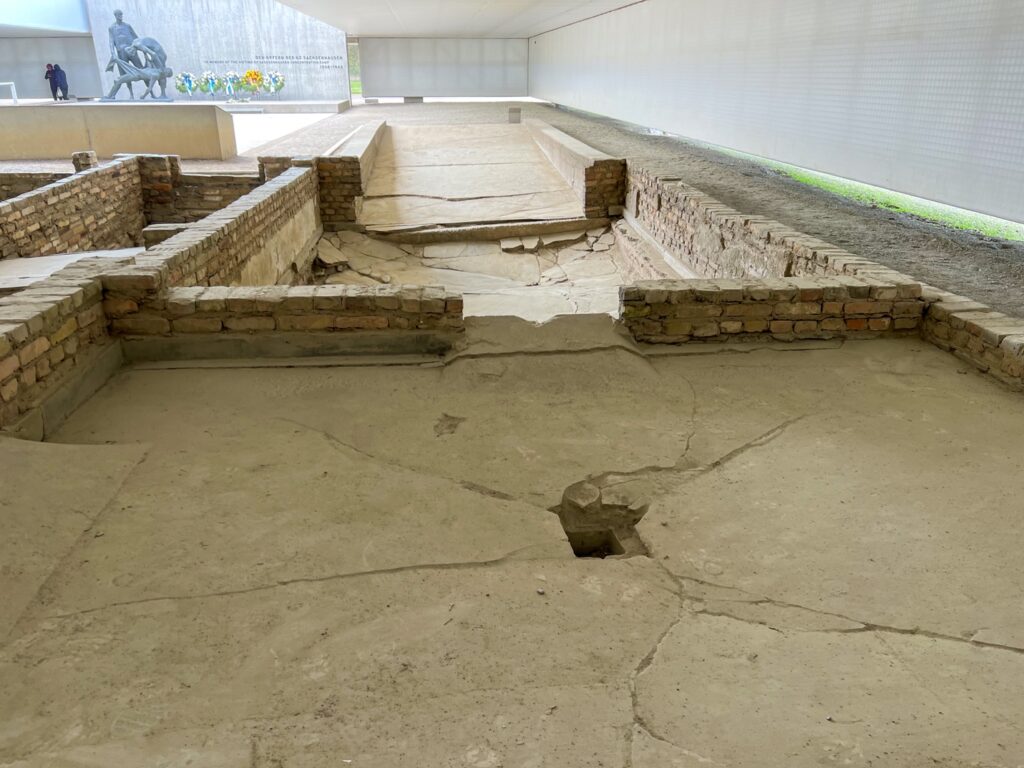
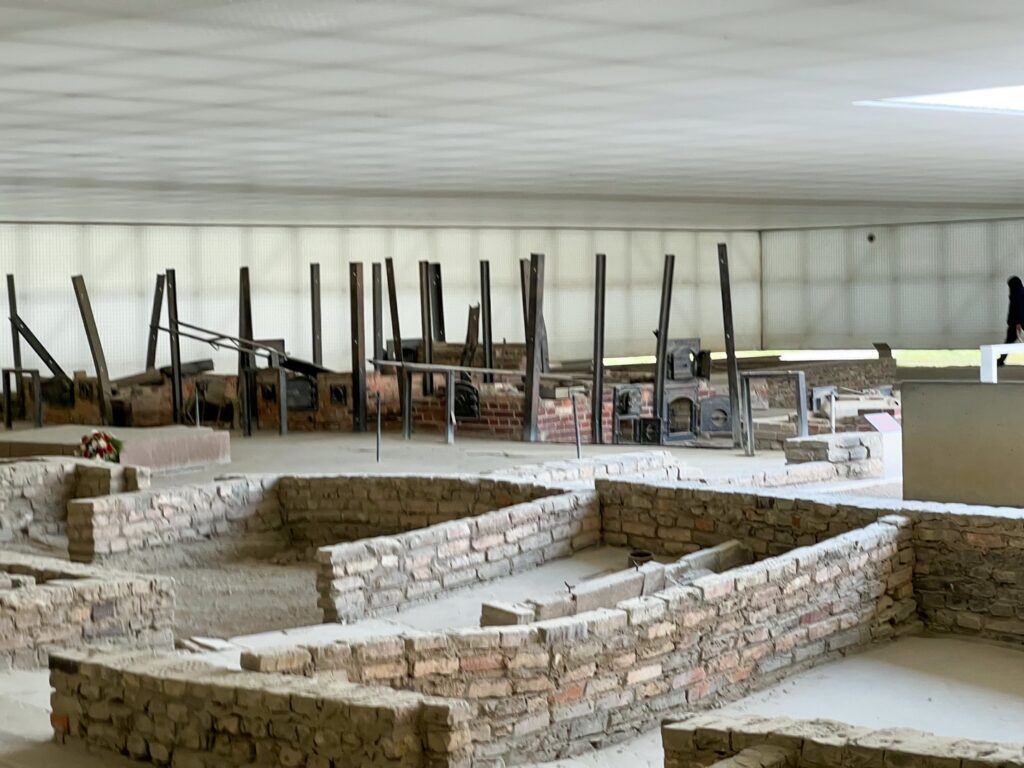
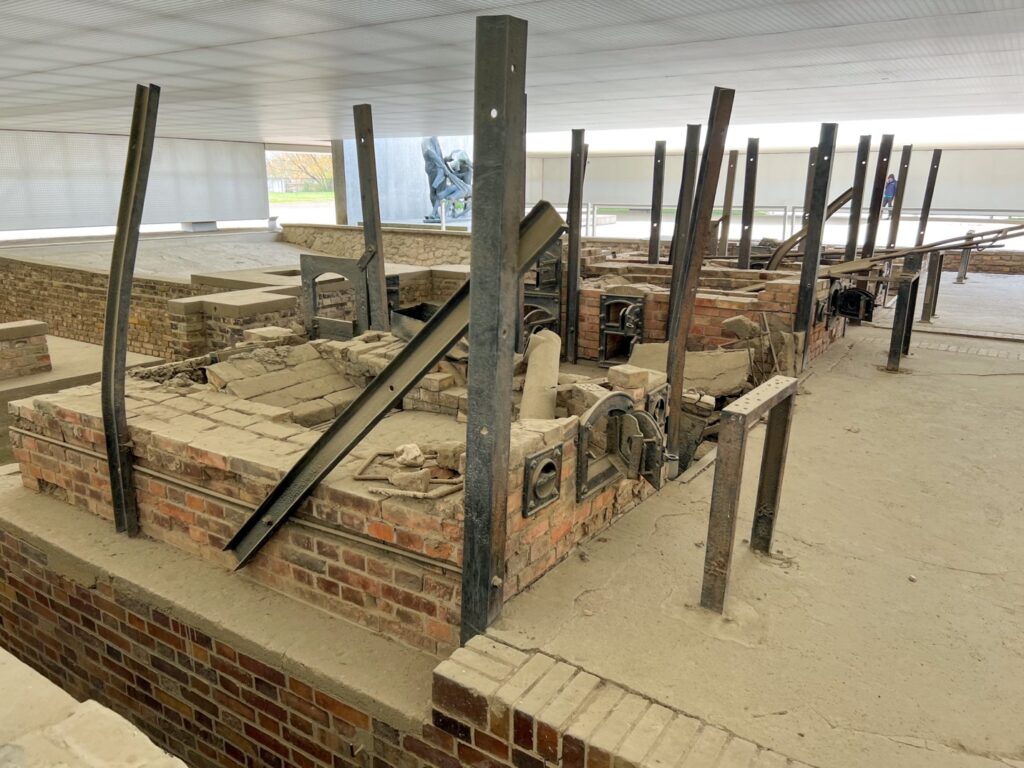
I’m thankful for the opportunity I had today, but it wasn’t enjoyable. It was poignant and powerful and depressing and educational and sad and hard and necessary.
Susan Neiman has an interesting section in her book Learning From The Germans about these concentration camp memorials and a conversation with the director of the Buchenwald Memorial. The Memorial there goes to great lengths to show the residents of the area knew exactly what was happening and chose to do nothing from the beginning of the camp being built there until the very end. The exhibits at Buchenwald and Sachsenhausen don’t just memorialize the dead and proclaim the suffering that happened. These camps — now turned memorials and museums — ask the bigger questions about how what happened was justified, why there was so little resistance, and what ideologies and actions led to what the camps and their acceptance by the German people.
For example, the residents of the Weimar region didn’t want Buchenwald named for the wood it was in because that wood was made famous by Goethe. They knew enough to know that the camp would stain that legacy, but they didn’t care enough to stop its construction, just it being named for their beloved wood. We think through more than we want to admit. We play ignorant, but we rarely are as we play. We think in playing ignorant we can still be found pure and clean and guiltless. It was not true for the citizens of Weimar and it will not be true for us if we let injustice linger and thrive in our towns and country.
The people of the town around Sachsenhausen knew what was happening: the camp and community were in a symbiotic relationship. They knew, but it’s also not so simple as they knew and let it happen.
Our guide made the point that the real question isn’t, “would you have done something, but when would you have done something?” People thought it was temporary because it was before and by the time things get really bad there’s the question of who do you endanger by speaking up and what can be done when things are already so bad and so established. Sometimes things happen so fast, the window for effecting change is already closed.
Sometimes you may know something is wrong but just have no idea how to stop it. Perhaps you’ve felt or feel like that. I lament all the mass shootings in the US. I know it’s wrong but I don’t know how to stop it. I’m not sure what I can do. As I see rights and opportunities taken away from groups of people, I know its wrong but I’m not sure what I can do to stop it. I can use my voice, but I’m not always sure what good that will do except get half the church mad at me, and what good does that do? That doesn’t mean we should never act, we should never speak up. It’s often not simple. There is the question of not only if, but how, and when, and at what cost. Some people who had little responsibility had an easier time taking a stand than those who felt responsible for aging parents and children. It’s hard to risk your own life, but it’s much harder to risk the life of those you love. That element was certainly in play during the Nazi regime in Germany and when East Germany was largely run by the Stasi.
We can’t just play this game of “what would I have done if I lived next to Sachsenhausen in 1939 or 1944?” That doesn’t do us any real good. The director of the Buchenwald Memorial doesn’t want people to come and put themselves in the place of the prisoners or guards or the citizens of the surrounding towns. He doesn’t want people to consider what they would have done in 1942 or ’44. He says, “Our memories are narrowed by the Holocaust, which shields us from the history of its causes. The real question is ‘What would I have done in ’32 or ’33? Then it’s a question about courage, but not a matter of life and death. And it’s not one you can answer by saying there was no chance for effective resistance.”
As I said in an earlier reflection, we have to act when a movement is beginning — not when it has the inertia to keep moving despite the roadblocks put in its way. Often we don’t know that “when” until it’s too late. Some Jews left Germany early and others kept thinking things would get better. It’s a difficult decision. When do you risk your livelihood, the life you’ve known, everything because you’re afraid you won’t have a life otherwise? How long do you wait? What if you’re wrong and leave too early?
I imagine that’s something many of the refugees in this country can tell us more about. For the most part, no one leaves their home and becomes a refugee because they want to or think it will be easy. They usually have no choice and it’s the hardest decision they have to make. I can’t imagine that kind of decision, and therefore try to have empathy for anyone who feels they have to risk everything to flee. What can we learn about why people choose to flee their homes today? Instead of just looking at statistics and facts of who is coming and from where and what it means for the nations that receive them, can we try to investigate and understand why they made that choice? What evil is pushing them out, leading them to make such a dangerous and costly choice?
We need to think about the causes of evil and not just memorialize its effects. I think that’s how these Concentration Camp Memorials and museums like the Topography of Terror, which we saw yesterday, help us. We aren’t just remembering something bad happened, we’re discovering why and how it happened.
What would that mean and look like for museums in the US? To not just teach what happened on the Trail of Tears, but really dig into who did it and why, and how everyone else was perfectly fine with sending the Cherokee packing from lands they had lived on for generations. What would it look like in a museum about slavery in the US to really examine why we had slavery and why the whole nation, not just the South, was content with the institution for so long? I think we’d uncover some horrible truths, but also learn things weren’t as simple as we might believe.
Courtney can tell you a lot about how it was actually illegal for most southerners to free their enslaved persons. And while some could upon their deaths, it could leave their family bankrupt and worse. Courtney says time and time again that people often have far less choices than we assume they have. But we oversimplify and we don’t study the why and the how, we often just settle for the what. We name what happened and move on.
The common model for museums and memorials is to celebrate the triumphs and heroes and mourn and memorialize the victims. Germany is doing something new: they are asking the right questions about the perpetrators, their motives, and the social conditions around them. When we can understand the why, we are better equipped to not repeat our past shame and evil.
In studying how and why the Nazi plan worked so well in Germany, it all feels really similar to so much in the US, from slavery and Jim Crow to Nixon’s Southern Strategy. It’s all there in the same playbook. While they’re not the same, it starts in the same place, appealing to the same fears and desires, making the same kind of promises.
What can we learn from that? What does it tell us about ourselves and our leaders and how the masses will allow injustice against some even if it doesn’t really benefit them?
Read more Berlin travel notes:
- Why Berlin? (4/16/23)
- Learning from Germans (4/17/23)
- Ghosts of Berlin (4/18/23)